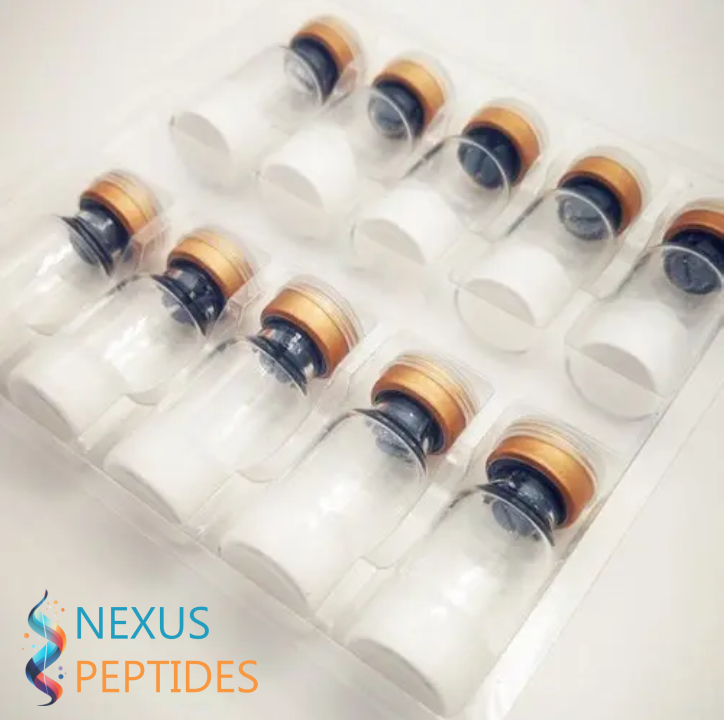

Product Description: Tesamorelin
Introduction:
Tesamorelin is a synthetic peptide that is often used in scientific research to study the role of growth hormone (GH) and its effects on various physiological processes. It is a modified form of the growth hormone-releasing hormone (GHRH), a naturally occurring peptide that stimulates the release of growth hormone from the pituitary gland. Tesamorelin has been designed to have a longer half-life compared to GHRH, making it particularly useful for laboratory studies that require sustained stimulation of GH release.
In research, Tesamorelin is widely utilized in studies exploring the mechanisms behind growth hormone regulation, pituitary function, and the impact of GH on metabolic processes. Its potential applications in the study of endocrinology, metabolism, and age-related conditions make it a valuable tool in scientific research.
What is Tesamorelin?
Tesamorelin is a synthetic analog of growth hormone-releasing hormone (GHRH), which stimulates the release of growth hormone from the pituitary gland. Tesamorelin has a modified structure that enhances its stability and prolongs its activity compared to the naturally occurring GHRH. This extended duration of action allows researchers to observe the effects of prolonged GH release, making Tesamorelin a useful tool in studies investigating the regulation of growth hormone secretion and its downstream effects.
While Tesamorelin is not intended for therapeutic use, its application in laboratory settings allows scientists to explore the role of GH in various physiological processes, such as metabolism, growth, and cellular function. It provides researchers with valuable insights into how the body responds to long-term exposure to elevated GH levels and aids in understanding conditions related to growth hormone dysregulation.
Potential Different Names:
- Tesamorelin acetate
- Egrifta (brand name in certain applications)
- GHRH analog
- Growth hormone-releasing peptide
- Synthetic GHRH derivative
Chemical Formula:
The chemical formula of Tesamorelin is C211H317N55O61S. This represents its molecular composition, including 211 carbon atoms, 317 hydrogen atoms, 55 nitrogen atoms, 61 oxygen atoms, and one sulfur atom, which contribute to the peptide's structure and function.
Structure:
Tesamorelin is a synthetic peptide consisting of a sequence of amino acids that mimics the structure of the naturally occurring growth hormone-releasing hormone (GHRH). Its structure is designed to enhance its stability, enabling it to remain active in the body for longer periods than GHRH. Tesamorelin has an extended amino acid chain compared to GHRH, with modifications that improve its ability to stimulate the release of growth hormone.
The structural modifications in Tesamorelin make it an effective tool for research purposes, as it allows for sustained GH release and provides more controlled experimental conditions. Tesamorelin’s molecular structure includes several key components that are essential for its function, including a sequence that interacts with GHRH receptors in the pituitary gland to promote the release of growth hormone.
How Does It Work?
Tesamorelin works by stimulating the release of growth hormone (GH) from the pituitary gland. It does so by binding to specific receptors known as GHRH receptors, which are located on cells in the anterior pituitary. Once Tesamorelin binds to these receptors, it triggers a signaling pathway that results in the secretion of growth hormone.
Growth hormone, once released into the bloodstream, plays a central role in various physiological processes, such as protein synthesis, metabolism, and tissue growth. By stimulating the pituitary gland, Tesamorelin mimics the effects of natural GHRH but with a longer-lasting effect due to its modified structure. The extended half-life of Tesamorelin allows researchers to study the impact of prolonged GH stimulation in experimental settings, which can provide insights into the role of growth hormone in both normal physiology and disease states.
In scientific studies, Tesamorelin is typically used in controlled environments to investigate the effects of increased GH secretion on metabolic processes, aging, and the functioning of various tissues and organs. It has applications in the study of growth hormone regulation, endocrinology, and metabolic disorders.
Conclusion:
Tesamorelin is a synthetic analog of growth hormone-releasing hormone (GHRH) used in scientific research to explore the role of growth hormone in regulating metabolic processes, growth, and tissue function. With its modified structure that extends its half-life, Tesamorelin provides researchers with a valuable tool for studying the effects of sustained GH release. By stimulating the pituitary gland, Tesamorelin helps scientists better understand the mechanisms behind growth hormone regulation and its potential impact on various physiological conditions.
As a research peptide, Tesamorelin enables detailed studies of endocrinology, metabolism, and age-related conditions without being intended for therapeutic use.
Disclaimer:
This product description is provided for informational purposes related to scientific research only. Tesamorelin is not intended for medical, therapeutic, or human consumption. It should only be used by qualified professionals in a controlled laboratory setting following appropriate protocols and safety measures. The information provided here is based on current scientific knowledge and is not intended to make any health-related claims.


